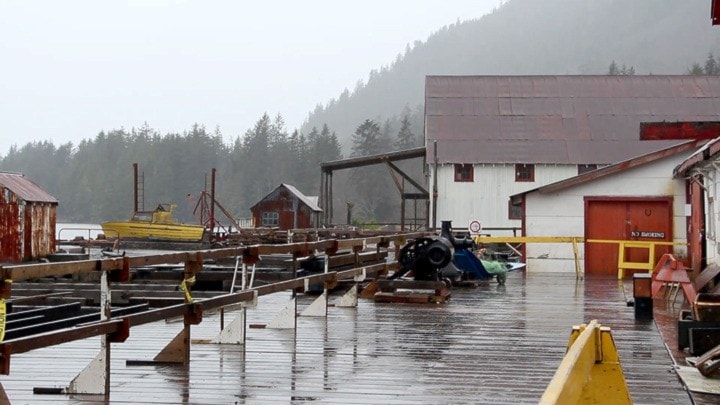The year of 2016 was a momentous one for the team running North Pacific Cannery National Historic Site (NPC). The District of Port Edward celebrated part of its 50th anniversary there over the summer and the site hosted Hallowe’en festivities for 554 attendees in October.
Revenues also jumped 12 per cent – a large increase over the usual two to three per cent jump every year, as did visitor numbers, which reached 9,386 attendees throughout the year, including special event activities like the anniversary and Hallowe’en, in addition to tours, educational programs for students and researchers and regular visitors (8,222 visitors excluding special events).
Steve Milum, conservation manager and Laurie Davie, the cannery’s new general manager for NPC, provided a lengthy update to the North Coast Regional District (NCRD) in its February board meeting.
“Restoring the North Pacific Cannery preserves our identity, culture and pride and creates a foundation for our future. I believe in that quite strongly, that we all have commonalities when we go back far enough,” Milum said.
The conservation manager highlighted the accomplishments completed last year by a team of 16 journeymen carpenters, carpentry apprenticeship trainees and workers who were on EI.
The apprentices completed a nine month program, gaining skills, work experience and more. The conservation work included finishing 4,500 square feet of the working dock, adding a fish loading bay, tearing down rotten parts of the roof, restoring a wing back to its 1923 state, and putting some coats of whitewash stain on the machine shop. The team also did some foundation work on the reduction plant south wall.

Steve Milum, the conservation manager for the North Pacific Cannery, presented to the regional district plans for the 2017 season, including plans for Canada150 celebrations. FILE PHOTO/THE NORTHERN VIEW
Milum explained that the conservation and restoration budget (which is separate from operations and maintenance) is essentially non-existent without the help of grant funding and partnerships from organizations such as the Province of B.C., Parks Canada, Heritage BC, and community partners like Broadwater Industries, Aluma Systems, Kristoff Trucking, Northern Health, Hecate Strait Employment Development Society, Northwest Community College and the District of Port Edward. Last year that funding totalled $738,000 for the trades training and conservation project.
On the financial side, Davie explained that the staff led numerous tours and is working on increasing signage for the site.
“We had 44 tours last year and that doesn’t sound like a lot, but it is when you have lots of people coming through and this year’s going to be even better,” said Davie, adding the site has 490 signs, with more on the way as part of the team’s interpretation strategy for unmanned tours.
“We have many revenue streams – admissions, tours, special events. We’ve done a lot of weddings – we have two coming this year that are quite sizeable. The gift shop did well, the cafe did well, as did accommodations,” Davie said.
Admin, staffing, maintenance, marketing and revenue centres’ overhead make up the site’s expenses. The board of directors is chaired by Bob Payette, with Davie, Karl Bergmann, Michael Gurney and Polly Pereira.
What’s in store for 2017?
As successful as last year was on the conservation and tour sides of the coin for the cannery, 2017 is shaping up to be just as significant.
The team is able to apply for up to $1 million (usually only $100,000 in the past) from a grant opportunity from Parks Canada, celebrating Canada150. The year also marks 150 years of B.C.’s salmon canning industry, with the first canning operations appearing on the Fraser River in 1867.
Twenty cruise ship excursions have been booked out of 21 cruise ships docking in Rupert this summer, with six Canada150 events planned for the country’s sesquicentennial celebrations this year. The tour script is growing with more detailed facts, and more signage is planned to pop up around the site. The Cannery Road Race and B.C. Heritage Fair are other attractions the cannery will host this year.
In its conservation efforts, new projects scheduled to be underway and completed by March of next year include finishing the last 7,900 square feet of the working dock with another skills-building team, restoring two boat lifts, possibly installing a breakwater to protect the site from trees and ice floes coming down the river every spring (dependent on a donation from the Port Edward Harbour Authority), restoring the east wharf to create access and provide tours, addressing some structural needs with the boiler plant, and finally, extending the First Nations village on the site by another 10-12 restored residences.
“There used to be almost 100 little houses out on a boardwalk that went down to the shoreline,” Milum said.
“We only have two houses on the site right now, but we’d like to expand it to at least a dozen so we can actually capture the atmosphere that would have been there and tell their story better. Those are big projects, plus building off of the conservation master plan, it’s now time to start interpreting all of the buildings that we’re stabilizing.”
The NCRD board was impressed with the update and suggested to the staff that they help train workers with office work as well, as it has been identified as a need in the area, along with their carpentry skills. Sixteen more labourers are being recruited for the projects.
As well, the board of directors for NPC are moving forward with an application to be named a UNESCO World Heritage Site.
“We’ve received quite an overwhelming number of letters of support ... The UNESCO process is probably going to be a five to 10 year period of [wait] time even if we get on the list, but it’s looking very encouraging that we’ll get on the list as one of Canada’s leading historical sites,” Payette said.
